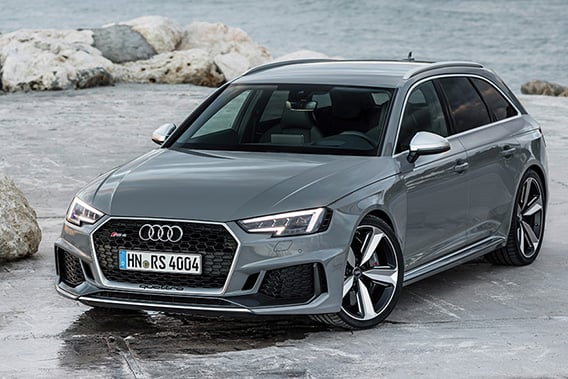
TELL ME ABOUT THIS CAR
Now in its fourth generation, the Audi RS4 ditches the big 4.2-litre V8 engine of the previous two iterations in favour of a smaller 2.9-litre turbocharged V6 powerplant. In that regard, it’s more akin to the 1999 original, which hefted a 2.7-litre turbo V6, and Audi is determined to prove that less – in this instance at least – is more.
While the engine’s capacity might be smaller than before, thanks to two turbochargers, it packs one heck of a punch. Power stays the same as before at 331kW, but the amount of torque this engine generates is quite different. In the old V8, you needed to wring the engine out above 4000rpm to access its full quota of 430Nm. In this current version, there’s a rippling 600Nm available form a mere 1900rpm. In other words, the RS4 now feels effortlessly rapid all the time. You don’t need to work the car hard to make rapid progress, and that means better engine efficiency, less driver fatigue and superior refinement.
Switched into its angriest setting, the RS4 feels devastatingly potent. Audi quotes a 0-100km/h time of 4.1 seconds and that feels extremely conservative. You also get a bunch of theatrical pops and bangs from the exhaust, but if you’d prefer to dial back the drama, the RS4 has a civilised side where it feels – and sounds – much like most other Audi A4 wagons, albeit one that compresses time and space when you commit to the right-hand pedal.
You’ll need around $155k (AUD) to get your hands on one, but the Australian cars include a number of equipment items such as a clever rear differential, sports exhaust and the ingenious Dynamic Ride Control system that are options in most other markets.
STRENGTHS
- The RS4 Avant feels truly multitalented. It can be refined and it rides well, but it also has a wild side to it.
- Fuel economy has improved markedly with the smaller turbocharged engine. The old 4.2-litre car returned a combined figure of 10.7L/100km whereas the latest model trims that down to a more socially acceptable 8.8L/100km.
- The quattro sport differential fitted to the rear axle helps the car sniff out any shred of grip available when powering out of a corner.
- Dynamic Ride Control is a clever diagonally-linked three-mode damper setup that helps cut out front end dive under braking, rear end squat under acceleration and body roll when cornering. Yes, it really works.
- The interior is beautifully finished, with quilted leather sports seats, carbonfibre fascia detailing, Alcantara accents, a lovely steering wheel and Audi’s jaw-dropping Virtual Cockpit dial pack.
- The exterior looks the part too. It’s subtly aggressive with rakish front air intakes, a roof spoiler, flared wheel arches and a rear diffuser. Audi’s also brought back Nogaro Blue paint, a signature colour of the 1999 original.
- The old car’s slightly awkward seven-speed twin-clutch transmission has been ditched in favour of a slick ZF eight-speed automatic. It makes low-speed manoeuvres feel smoother, yet its reaction speed when you’re driving fast is right on the money.
- You get 505 litres of luggage space in the back up to the tonneau cover, and 1510 litres when you drop the 40/20/40 split rear bench.
- There’s an inductive charger that can wirelessly charge your mobile.
- Despite the RS4’s sports focus, you still get a comprehensive suite of safety equipment including autonomous emergency braking, a lane-change assistant, an adaptive cruise control system with a traffic jam mode, and a clever collision avoidance system that helps the RS4 avoid obstacles by guiding the car into a safe lane. Then there’s cross traffic assist, road sign recognition and the usual suite of airbags and brake boosting tech.
- This RS4 debuts car-to-X technologies, whereby traffic sign and road hazard information can be signalled to other Audi models so that they can exchange information via the Audi connect SIM in almost real time.
WEAKNESSES
- The steering could be a little more lively in its feedback.
- The drive select switch – a feature you’ll use often – is a stretch away on the left-hand side of the fascia. It’s evidence of a lazy right-hand drive conversion but it is possible to allocate one of the steering wheel buttons to duplicate the job.
- A shift lever that pushes forward to change up has no place on a performance car.
- Carbon ceramic front brakes are a $12k (AUD) option. For comparison, Mercedes charges $10k (AUD) for composite brakes on the front of its C63 AMG wagon.
- The 58-litre fuel tank isn’t going to give the RS4 the range its lovely long-legged ride deserves.
- Are you prepared to pay more than $50k (AUD) on top of the already rapid Audi S4 wagon?
ANY RIVALS I SHOULD CONSIDER?
The Audi RS4 offers a unique blend of talents, but if you’re looking for a hot wagon, take a look at the Alpina B3 Biturbo and both the Mercedes-AMG C43 Estate and the Mercedes-AMG C63 S Estate. The former has all-wheel drive (like the RS4) and the latter has neck-snapping pace (like the RS4).
You can’t have both attributes with a three-pointed star. It’s also worth considering Porsche’s Macan Turbo with Performance Pack. It’s extremely quick, features all-wheel drive, and is almost lineball with the RS4 on price.



